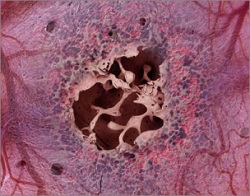 |
| Microscopic view of the engineered bone in the bone marrow-on-a-chip--Courtesy of James Weaver, Harvard's Wyss Institute |
Scientists at Harvard's Wyss Institute for Biologically Inspired Engineering have unveiled their newest tool for drug testing, dubbed "bone marrow-on-a-chip," the first device of its kind that mimics the structure, functions and cellular make-up of bone marrow.
Bone marrow is made up of complex tissue and has, up until now, primarily been studied intact in living animals. Like the Wyss Institute's other organs-on-chips technology, the newly engineered bone marrow could provide scientists with a more accurate alternative to testing on animals. Wyss scientists hope the device could be used to help develop treatments to reverse cell death in bone marrow caused by radiation.
In an initial test with backing from the FDA, the engineered bone marrow imitated human marrow when it was exposed to radiation. When tested with a drug known to prevent radiation poisoning, the bone marrow-on-a-chip was unharmed. The findings are detailed in the May 4 issue of Nature Methods.
So far, Wyss scientists have built lung, heart, kidney and gut chips that reproduce important aspects of organ function using a technique that combines multiple types of cells from an organ on a microfluidic chip. But Wyss scientists needed to take a different approach to create engineered complex bone marrow that mimicked the real thing.
Investigators packed dried bone powder into an open, ring-shaped frame the size of a coin battery and implanted the mold under the skin on a mouse's back. After 8 weeks, the disk-shaped bone that had formed in the mold was surgically removed and examined with a CT scanner. The CT scan revealed a honeycomb-like structure that looked identical to natural trabecular bone, which holds bone marrow. In addition, the new bone marrow was saturated with red blood cells, resembling marrow from a living mouse.
After surgically removing the engineered bone from the mice, the researchers kept the bone marrow alive outside of the animals by placing it in a microfluidic device designed to steadily supply nutrients and remove waste, similar to what the tissue would experience in the body. The engineered marrow in the chip remained healthy for up to one week--long enough to use the device to test the toxicity and effectiveness of a new drug.
- read the press release
- see the study abstract